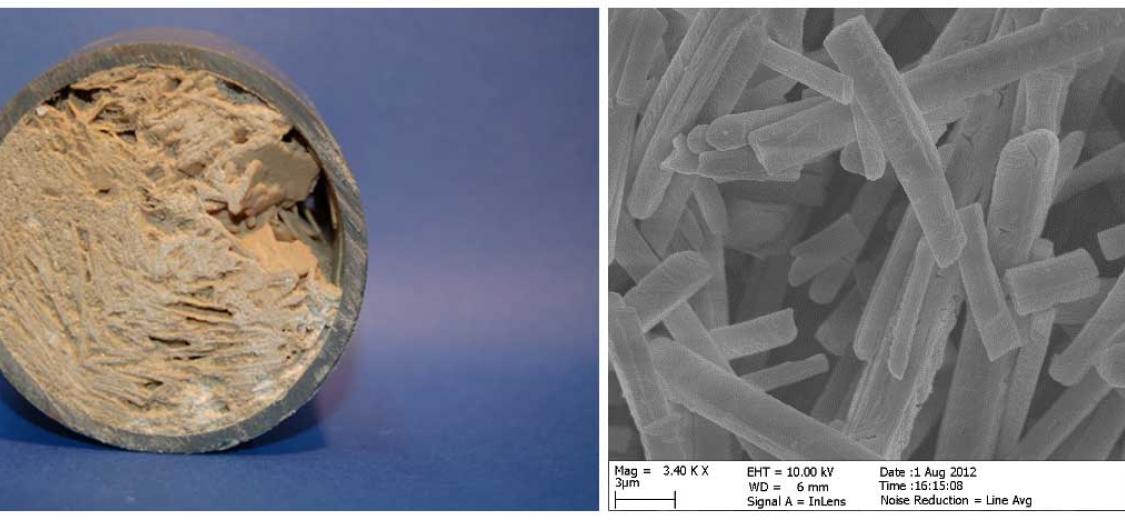PERSONNEL
| PETROS KOUTSOUKOS | 2610997265 | pgk@chemeng.upatras.gr |
| STAMATIA ROKIDI | 2610997265 | s.rokidi@chemeng.upatras.gr |
| EVAGGELOS ATHANASSOPOULOS | 2610997579 | ath.evaggelos@chemeng.upatras.gr |
| Laboratory webpage (or of research group): | ||
DESCRIPTION
The formation of crystalline particles from aqueous supersaturated solutions and from melts is a very important process underlying a quite broad spectrum of phenomena including salts or organic compounds crystallization and separation of polymorphs (food and pharmaceutical industry), scale formation and fouling in industrial water intensive processes (cooling towers, heat exchangers), preparation of powders with tailor made characteristics, biological mineralization etc. Understanding the mechanism of these processes is a prerequisite for their effective control in supersaturated solutions. Aside from the above mentioned applications, crystallization may be used as a tool for the recovery of raw materials from wastes (phosphorus from municipal wastewaters and polyphenols from olive mill wastewater). Adsorption of substances at the crystal/ solution interface is an important mechanism of transport of pollutants from the aqueous phase to the solids. Precipitation and or crystallization in the presence of pollutants is among our research interests. Charge transfer reactions at the metal/aqueous solutions interface are typical for metal corrosion. These reactions may be favored by the presence of scale deposits. The relationship between these two processes is within the research interests of our Laboratory.
The dissolution of sparingly soluble salts in undersaturated solutions is of paramount importance in understanding the behaviour of materials exposed in the atmosphere. Mechanistic investigations are needed in order to understand the deterioration of the building materials of the built cultural heritage at the molecular level, so that the most suitable remediation methods may be designed. The investigations in our laboratory are focused in these two tasks.
EQUIPMENT
The equipment of the Laboratory of Inorganic and Analytical Chemistry, besides the wide range of reactor types and controlling units (based on potentiometric sensors- ISE and conductivity) for crystallization studies both at ambient and at elevated temperature (hydrothermal conditions) includes an array of analytical instruments for the characterization of solutions, solids and gases. Specifically, the analytical instruments which are used both for research and services include: Atomic Absorption Spectrometer with Graphite Furnace (GFAAS, PERKIN ELMER AAnalyst 300), Ion chromatograph with anion exchange column (DIONEX DX-120), Liquid chromatograph (HPLC) with UV-VIS detector (VARIAN LC 5000), gas chromatographs with TCD and FID detectors(GOW MAC and VARIAN), streaming potential apparatus for the measurement of ζ potential, particle number and particle size distribution counter (SPECTREX ILI-1000), UV-VIS spectrophotometer with integration sphere for DRS spectra (Perkin Elmer l-35), powder x-ray diffractometer (Siemens D-5000), thermogravimetric analysis apparatus (TGA, TA Q50) over temperature range 20- 1000⁰C, tensiometer for surface tension measurements of liquids (static and dynamic) (Sigma 70, LKB). Moreover electrochemical analyzers and electrochemical measurements devices capable of both AC and DC measurements are available (EG&G and EDAQ). Using the analytical equipment of the laboratory we have provided services in the past to public and private services like Municipal Water treatment Authority, Archeological Ephorates, the fire department, pharmaceutical and medical materials companies, photovoltaic companies from the industrial zone of Patras, metallurgical and construction companies, food industry etc.
PROJECTS - RESULTS
Recovery of raw materials from wastes: Ι. Phosphorus recovery from municipal wastewater. The method of constant solution supersaturation has been used in a continuously operating crystallizer the operational parameters of which are investigated in order to obtain optimal conditions (rate and yield) for phosphorus and ammonia recovery from municipal wastewater in the form of ammonium phosphate hexahydrate, a fertilizer. Different types of reactors are being tested (batch, fluidized bed, continuous crystallizers). ΙΙ. Phenol recovery from olive mill wastewater by cooling crystallization. Investigation of the possibility and efficiency measurement for the recovery of high added value products from olive mill wastewater with high polyphenol content. The method of layer cooling crystallization is applied varying the temperature gradient at the stainless steel-fluid interface.
Conservation of building materials of monuments of cultural heritage : Investigations of the mechanisms involved in calcitic and limestone materials deterioration exposed in aqueous media over a pH range between 5 (acid rain, pollution from acid oxides of nitrogen and sulfur) up to 8.5 (alkaline environment, e.g. contact with Portland cement in restoration). Development of protection methodologies based on the mechanisms of deterioration. Development of protective coatings and investigation of the protection effectiveness (coatings of titania, calcium oxalate etc.).
Inhibition of scale formation and of the corrosion of steel and aluminium: The investigation of the mechanism of the formation of sparingly soluble salts is of key importance for the development of methodologies to solve scale formation problems. Scales of BaSO4 and mixed salts formation consisting of CaSO42H2O /CaCO3 are systems studied currently. The investigations of corrosion of metals, with and without scale deposits are under investigation with both DC (potentiodynamic curves measurements) and AC measurements (impedance measurements).
Biological Mineralization: Mechanistic investigations of the formation of the crystalline phases of calcium phosphate in tissues and other biogenic surfaces at steady state conditions (continuous crystallizers). The development of this type of reactors in our laboratory allows for the unequivocal uncovering of the role of transient calcium phosphate phases in the process of formation of hard tissues.
